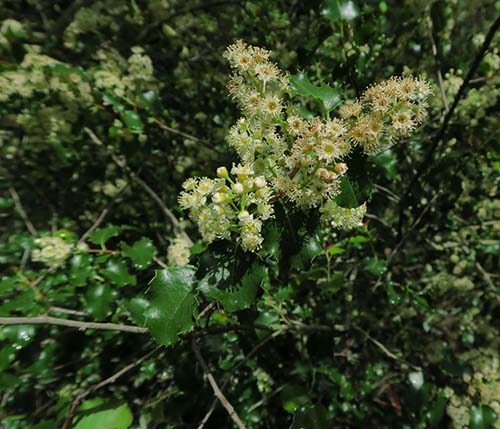
Hollyleaf Cherry, sometimes referred to as Evergreen Cherry, is a popular plant because of its beauty and its sweet-tasting cherries. It can grow up to 30 feet tall and is called both a shrub and a tree. It typically averages out at around 14 feet when used in landscaping. Its height and dense foliage make it a good choice for privacy hedges.
Appearance and Cherries
It’s easy to mistake Hollyleaf Cherry for Holly. They both have glossy green leaves with sharp points on the edges. True Holly’s berries are bright red, smaller than the fruit of the Evergreen Cherry and grow in tight clusters. This plant’s cherries hang like grape clusters, and the fruit isn’t densely packed together.
The flowers of both plants are creamy white and similar in size. This shrub’s small flowers have frilly-edged petals and pale yellow, Daisy-like centers. They have a discernible, pleasant fragrance. This plant is a year-round beauty. The flowers start to bloom in March and drape the shrub in white petals. In fall, the red cherries will brighten up your garden, and the leaves keep their true green color all year.
The cherries are edible. Take care to remove the single large seed before eating a cherry. They can be toxic. You may like to leave the cherries for birds and small wildlife.
Planting Requirements
Hollyleaf Cherry grows wild in the desert and coastal chaparral. It requires full sun. Plant it on slopes to create a windbreak and slow soil erosion. A good companion plant for this shrub is Coffee Berry. Landscapers recommend planting them together when creating a privacy hedge because Coffee Berry grows at a faster rate. You may need to thin seedlings when the plants are established.
Soil for this shrub should be well-draining. Speak to your landscaper about adding richer soil at the time of planting.
Adult plants need monthly watering during summer. New plants may need weekly water.
Wildlife
Like Coffee Berry, this shrub provides food for a variety of popular birds. Small animals also eat the cherries. Hollyleaf Cherry provides important winter shelter for birds. It’s not of interest to deer.
This is a host plant for the caterpillars of the pale swallowtail butterfly. Its flowers attract other butterflies as well as bees.
Landscaping
In addition to using this plant as a privacy hedge, you can plant it close to your house and have it pruned twice a year to keep it at a standard hedge size. Young trees are available for homeowners who want to establish a windbreak. Birders may want to add two or three plants to their gardens. Whatever your planned use, this plant will be visually pleasing all year.
Things to Remember:
- This large shrub will grow into a tree without pruning
- The berries are edible after the pit is removed
- Birds and butterflies rely on this plant for food and shelter
Don’t be intimidated by Hollyleaf Cherry’s size. We’ll help you care for it. Contact us today for all your drought-tolerant landscaping needs.
